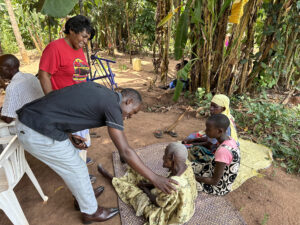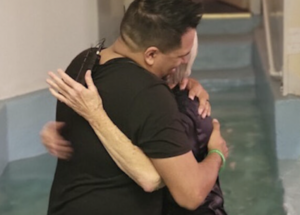
CENTRALIA, Mo. (BP)–I adamantly oppose the recommendations of the Great Commission Resurgence Task Force. If approved, I believe it will likely set North American mission work back many years, greatly diminish the Cooperative Program and could unravel the Southern Baptist Convention from top to bottom.
For the first 50 years of our convention, home missions work was done much in the same way the task force recommends. Both state conventions and the Home Mission Board (then called Board of Domestic Missions; now, the North American Mission Board) were doing missions in the same areas, most of the time competitively rather than cooperatively. Both developed their own strategies, fielded their own missionaries and solely funded their own projects and personnel. The work was in total disarray. The board struggled constantly for necessary funds, time and again facing bankruptcy and demise. Both state conventions and national entities went with “hat in hand” seeking financial support. Most early presidents of the board only served a few years and some only a few months before resigning in frustration.
Isaac Taylor Tichenor, one of the most outstanding of our Southern Baptist leaders, was elected president (or, as they called it then, corresponding secretary) of the Home Mission Board in 1882 and served until 1899. He was rightly called the “father of cooperation.” Tichenor realized how futile and unproductive it was for the board and the state conventions to be doing the same thing in the same place at the same time and how much better it would be to be do it cooperatively rather than competitively. He traveled personally by train, stage coach and buggy to every state convention office to sit with their leaders, appeal for cooperation and to work out cooperative strategies. The results changed the life of Southern Baptists from that point on. When he took office, the board had only 34 missionaries and receipts totaled only $28,370. When he completed his 17-year tenure, there were 623 missionaries and receipts totaled $179,564! Best of all, at last state conventions and the SBC had come together cooperatively as separate pieces of the same cloth.
This cooperative approach to home missions has continued ever since with varying degrees of success. For most of the first half of the past century, both state conventions and the board struggled for financial support, time and again facing periods of severe recession. Each entity, including the Home Mission Board, had “agents” who toured the country speaking at churches, associations, state conventions and anywhere else they were invited, raising funds and friends. The board still maintained “regional offices” where they attempted with limited success to plan mission strategy and supervise mission personnel. Efforts at cooperative planning, joint appointments and funding of mission personnel were haphazard and non-structured to say the least. Sometimes it worked well and sometimes not so well. There were no codified guidelines or contractual documents to guide the process and the results were sometimes chaotic. Nevertheless, from Tichenor on, cooperation rather than competition was the way missions was done throughout the United States.
But the funding problem continued. How could Southern Baptist members and churches give through a single channel and be assured no important ministry or cause, especially home and foreign missions, would be neglected? The answer was the “Cooperative Program.” Many have declared this, and I believe rightly so, the greatest, most effective mission support system in the history of Christendom. Through this channel, both state convention and SBC causes are funded, the exact appropriations determined after careful study by state convention and SBC leaders. As some have observed, the Cooperative Program is not a “sacred cow,” but it might be considered a “sacred how.” It is certainly not the only way we have sought to fund our ministries nor is any church or member required to give anything through the Cooperative Program. We have always celebrated and encouraged giving through the Lottie Moon and Annie Armstrong missions offerings and special offerings for associations, state conventions, etc. But strong priority has been given the Cooperative Program and every church encouraged to give generously, hopefully at least 10 percent of their undesignated income. This has not only, in large part at least, solved the problem of adequate funding for SBC ministries but laid the foundation for the unprecedented progress made by our denomination in the last half of the 20th century.
In 1954, Samuel Courts Redford was elected the 13th president of the Home Mission Board. I believe, second only to Isaac Tichenor, Redford was the most effective home missions leader to ever occupy that office. It was Redford who led Southern Baptists to “get out of Dixie” and develop a strategy to evangelize and start churches in every state of the union. A massive effort was launched to plant new churches throughout America and our territories. It was Redford who led the effort to accelerate evangelizing and starting churches in ethnic areas, one of the greatest success stories of any denomination in the past century. For the past several years, half the new church plants reported by Southern Baptists have been either ethnic or African American churches. Many language groups now have more Baptist churches in America than in their native country. Some have declared Southern Baptists the most ethnically diverse denomination in America.
Courts Redford and Arthur Rutledge, then director of the missions division of the Baptist General Convention of Texas, were attending a ball game together in Atlanta sometime in the late 1950s. As they discussed missions, they began to lament the haphazard approach state conventions and the board were using in planning and implementing cooperative strategy. There, that bright summer day, they drew up the first “cooperative agreement.” This worked so well with Texas that Redford invited Rutledge to join the HMB staff to help develop such agreements with other state conventions. Now, every one of our state conventions has entered into such agreements.
Cooperative agreements spell out in detail exactly what mission projects and personnel will be cooperatively funded and what percentage each entity will contribute. In each case, the amount is carefully researched and agreed to by both entities. Of course, larger state conventions with more resources contribute a much larger amount and the board much less, both in percentage and dollars. In newer, weaker conventions, just the opposite is true. In those states the board may contribute 90 percent or more of jointly approved projects and personnel, many of them church planters. In newer conventions, the board helps support missions and evangelism staff who in turn serve as our regional coordinators. This eliminates the need for expensive NAMB regional offices duplicating the services already being done by state staffs. In this way, the board is able to leverage their funds with that of the state conventions, doing much more with much less expenditure. (Historically, the International Mission Board has had over twice the income of NAMB with approximately the same number of mission personnel). Perhaps most important, cooperative agreements with every state convention assured the HMB would have a presence in every state, not just the newer state conventions. This enabled them to develop and implement a national strategy, not just a regional one.
In all cases, both state conventions and NAMB have the right to do work separately and independently, and sometimes choose to do so. No one owns the territory of a state convention! If NAMB perceives a need or opportunity but the state convention does not see it as priority, they are at liberty to field a missionary and solely support the project, and vice versa. However, for the most part, both the board and the state conventions have seen the wisdom of doing missions cooperatively rather than competitively.
The success of Southern Baptists in America in the last half of the 20th century is a source of admiration of religious leaders around the world. Since the 1950s, while all other mainline denominations were decreasing annually in members and number of churches, Southern Baptists have doubled in members and nearly so in churches and church-type missions. We have grown from a backwoods denomination into the largest Protestant denomination in America, and from a home missionary force of 754 in 1950 to a present count of over 5,000. We are now planting over 1,500 new churches every year, far more than any other denomination now or perhaps ever in history. As already stated, half of these are ethnic and African American. You might argue that God has blessed Southern Baptist more than any denomination in the history our nation.
So, why do I oppose the recommendations of the Great Commission Resurgence Task Force?
1. I believe their recommendation that we scuttle the cooperative agreements with state conventions and do missions independently with regional offices to deploy and supervise mission personnel would be a strategic nightmare. It would return us to the 19th century and the days prior to Isaac Tichenor and the chaos and disarray characteristic of home mission work at that time.
2. Although the GCRTF report states that the North American Mission Board will retain the leadership of reaching North America for Christ, the task force is essentially relieving NAMB of the major responsibility for language and ethnic missions, which would defy and destroy one of the greatest mission endeavors of this century. The success of Southern Baptists in language missions through the HMB/NAMB is unparalleled. No denomination has done so much or so well. It would be assigning territory to an entity where yet another is already at work successfully and has been for over 150 years.
3. The recommendation that we “celebrate” all manner of giving to SBC causes is appropriate but redundant, since we already “celebrate” these contributions. But to suggest anything and everything a church might do is “cooperative” and should be given equal status as the Cooperative Program has the potential of destroying the very “lifeline” of mission support.
4. Worst of all, I believe these recommendations, if approved and implemented, have the potential of “unraveling” the SBC from top to bottom. Until one has served as a home missionary (as I did for 10 years) or on a state convention staff (as I did for four years) or on the HMB/NAMB staff (as I did for 10 years), one may not realize how important these working relationships between state conventions and national entities are. Withdrawing NAMB financial support from these newer state conventions would likely destroy some of them and greatly weaken all of them. I think it not a stretch to say this is the “glue” that holds us together — a mosaic of many parts but one big picture. As the late James Sullivan said, our denomination is a “rope of sand with strength of steel.” I think the “steel” in this “rope of sand” is Southern Baptists working together in cooperation and joint venture as we seek to fulfill the Great Commission.
This is not to say everything in the recommendations of the task force is wrong. Certainly, all of us agree with the strong exhortation to make fulfilling the Great Commission a top priority. We resonate with the strong appeal for spiritual awakening in North America. We certainly agree far more needs to be done in starting churches and winning souls in America, Canada and around the world. Even though America represents only 4 percent of the world’s population, Southern Baptists have grown more, started more churches, and won more people to Christ than any Baptist group in any nation in history. But much, much more needs to be done and the task force has given some pertinent suggestions.
I think there is much in the findings and recommendations of the task force that needs to be studied carefully and prayerfully by the staff and directors at NAMB and by the staffs and boards of the state conventions. I believe the appeal that every state convention direct a larger percentage of their Cooperative Program receipts to national and world causes outside their own state is appropriate, and every state convention should move toward that goal. State conventions need to seriously consider how they can be less dependent on NAMB for missions and evangelism staff support so even more funds can be freed for church planting, evangelism and redemptive ministries. These are good recommendations and should be taken seriously.
My recommendation is that the report, findings and recommendations of the Great Commission Resurgence Task Force be referred to the North American Mission Board and the SBC Executive Committee for careful and prayerful consideration and implementation as they think appropriate and that they report to the 2011 annual meeting as to how they have responded to the report. Further that we respectfully request the state conventions to also study the findings and recommendations and invite them to report in writing to the SBC Executive Committee any actions they may have taken in response to the report.
My deep and sincere appreciation to the members of the Great Commission Resurgence Task Force for the hard work and long hours they have expended in preparing this report.
–30–
Larry Lewis is a member of First Baptist Church in Centralia, Mo., who served as president of the former Home Mission Board (now North American Mission Board) from 1987-97.
















